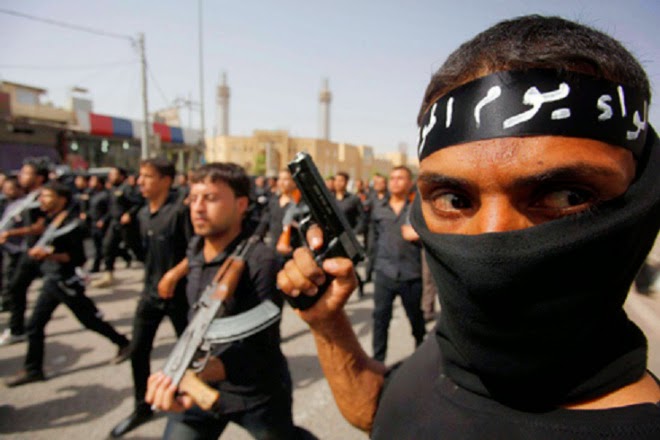A new battlefront in Libya emerged last weekend, when fighters loyal to the Islamic State of Iraq and the Levant (ISIL) clashed with armed groups from the city of Misrata loyal to the Islamist “Libya Dawn” alliance.
After detaining four ISIL fighters in the central coastal city of Sirte, Misratan officials say ISIL erected a checkpoint east of the city on the highway to oil-rich Sidra. While on their way to dismantle it, Misratan forces were ambushed in a deadly firefight.
“We were driving in our cars with our guns ready,” said Faisal Harish, a wounded fighter from his hospital bed in Misrata. He is part of Brigade 166, which was deployed to Sirte to address the ISIL threat. “There were at least a hundred that attacked us from the side of the road.”
Misratan forces from the Libya Dawn alliance arrived on Saturday to seal off the highway leading into Sirte from both the east and west, and to reinforce their military clout along its southern edge.
The Misratan officials estimated that around 500 ISIL fighters are inside Sirte, the hometown of toppled Libyan leader Muammar Gaddafi and his small Gaddafa tribe.
On Sunday, ambulances and fighters in pickup trucks, loaded with weapons, massed along the road next to the western front line.
Armed men at checkpoints were turning back the few civilian cars trying to enter the tense and dangerous city. “A group of ex-Gaddafi loyalists are in there with Daesh,” explained Adel Ben Guzy, the military leader for Brigade 166, using the Arabic acronym for ISIL.
So far, six Misratan troops have been killed, with dozens more wounded. Misratan officials estimate that up to 25 ISIL fighters were killed, with many more wounded or taken prisoner.
Seventeen bodies of ISIL fighters were flown to a morgue in Misrata for investigation. However, ISIL fighters have taken control of Sirte’s Ibn Sina hospital, making it difficult to track ISIL casualties.
On Monday morning, the conflict came to Misrata, 240 kilometres west of Sirte, when ISIL claimed responsibility for a deadly explosion outside the Brigade 166 headquarters killing one person.
ISIL is a new phenomenon in Libya, exploiting the power vacuum following the violent overthrow of Gaddafi in 2011.
Now, two different governments – one based in Tripoli, the other in Tobruk – claim the right to rule Libya, while militias and armed tribesmen continue to feud over power and the country’s resources.
In January, ISIL managed to shock a nation numbed to constant violence by carrying out a high-profile attack at the luxurious Corinthian hotel in Tripoli in January, and by the videotaped beheading of 21 Egyptian Coptic Christians on a Libyan beach.
Fighters pledging their allegiance to ISIL’s self-proclaimed caliph, Abu Bakr al-Baghdadi, entered Sirte more than one month ago.
However, so far only the ISIL group in Derna, long a stronghold of Islamists who resisted Gaddafi at home and sent many fighters to Afghanistan and Iraq, has been recognised by al-Baghdadi.
ISIL fighters have capitalised on disorder within hardline Islamist armed group Ansar al-Sharia, following the death of their Benghazi branch leader in January.
Mohamed al-Zahawi had been part of Libya Dawn’s fight against General Khalifa Haftar’s “Dignity” forces and Libya’s Tobruk-based government.
Brigade 166 was posted to Sirte’s outskirts soon afterwards, to expel ISIL from government buildings and
checkpoints. Powerful local tribes urged Brigade 166 to do this peacefully.
Haftar – along with Egypt, the United Arab Emirates, and western countries – have condemned Libya Dawn’s approach of ‘containing’ ISIL rather than directly attack them. Haftar accused Libya Dawn of complicity with ISIL.
According to many Misratan military and civil leaders, Sirte is considered a more manageable security threat than battling Haftar.
They claimed that those fighting under the ISIL banner include former Gaddafi supporters, criminals and foreign fighters, who could be dealt with after the battle of Sidra was settled.
But now, the Misratan forces are stretched thin. Libya Dawn is embroiled in battles against Haftar’s forces in Benghazi, in Sidra, and in Libya’s west and south as well.
“We are against terrorists in all forms, but not to do it Haftar’s way, which is to destroy a city and make families flee, all to end a couple hundred terrorists,” Ismael Shukri, a spokesman for forces allied with Libya Dawn, told Al Jazeera last week before the clashes with ISIL.
Shukri was alluding to the destruction in Benghazi resulting from the gruelling fight between Libya Dawn and Dignity forces there.
“We need to finish this now,” said Ali Abusetta, a member of Misrata’s city government bound for Brussels next week to attend the next round of United Nations-brokered talks between local Libyan officials. In his opinion, the biggest threat Libya faces is from Haftar – not from ISIL.
“The ISIL car bomb outside [Brigade] 166 on Monday was a message to make Misratans feel afraid. We are not sure if it will become a big problem,” said Abusetta.
“The families are behind us, but we are tired,” he sighed. “We want to stop the fighting and have a dialogue without blood.”



